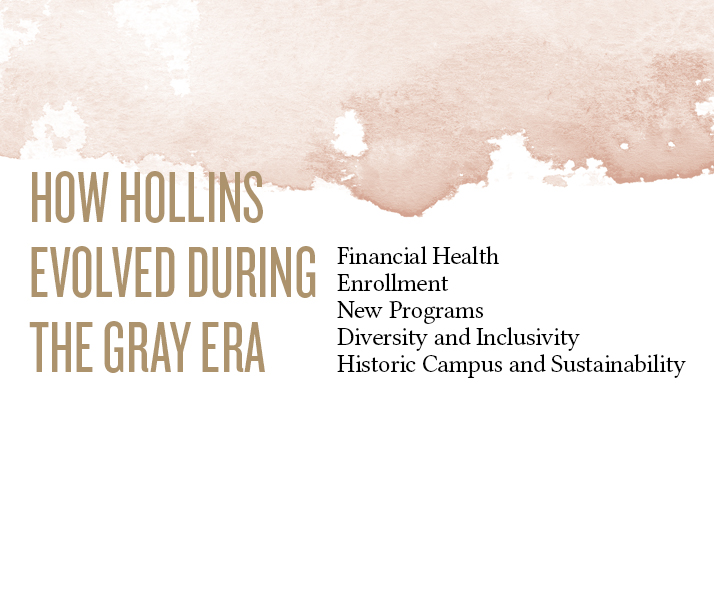
How Hollins Evolved During the Gray Era
The twelve and a half years Nancy Oliver Gray has presided over Hollins have been a time of stability and innovation for the university, a particularly remarkable feat considering Gray reigned during the Great Recession and at a time when both women’s colleges and liberal arts colleges faced distinct challenges.

Financial health:*
$161 million: 2016 endowment
$101 million: 2005 endowment
$86 million: 2000 endowment
* The National Association of College and University Business Officers and the Commonfund Institute
![]()
- When Gray arrived on campus, Hollins had $15 million in debt. By 2007, the university had retired its debt. Hollins has operated under no debt and with a balanced operating budget for the last decade.
- In its list of College Financial Grades for 2016, Forbes issued Hollins an “A” rating.
- The Campaign for Women Who Are Going Places was the university’s largest ever comprehensive fundraising campaign and the largest ever undertaken by a women’s college in the South.
Goal: $125 million
Raised: $161 million
- In November, Hollins announced the largest single gift assurance in school history: $20 million from Elizabeth Hall McDonnell ’62, and her husband, James S. McDonnell III, through the JSM Charitable Trust.
“For me fundraising is all about building relationships, with people who care or potentially could care about your institution and matching up their personal passion with an institutional need,” Gray explained when asked why she’s been so successful at raising money. “When you ask, you’re not asking for yourself. You’re giving the other person an opportunity to meet an institutional need in a way that hopefully is meaningful to that person.”
![]()
Enrollment:
Number of enrolled first-year undergraduate students
2016-17: 226
2015-16: 196
2014-15: 166
2013-14: 148
- The largest class of incoming new students in seventeen years started in August. “I hope it can be sustained,” Gray said. “We’re where we want to be now.”
![]()
New Programs
- New majors in environmental studies and environmental science
- A new concentration in data analytics

- A certificate program in musical theatre performance
- A certificate program in leadership studies
- An extensive seminar program for first-year students
- A faculty-designed honors program that complements the university’s academic curriculum and provides students a multidisciplinary and research-based experience
 M.F.A. programs in playwriting and children’s book writing and illustrating
M.F.A. programs in playwriting and children’s book writing and illustrating- An emphasis on making Hollins a year-round campus. In June, Hollins hosts the weeklong Tinker Mountain Writers’ Workshop and Women Working with Clay Symposium. Later in the summer, for six weeks, Hollins is a coed campus for graduate students. In July, high-school women attend Hollinsummer programs in theatre, riding, and writing. Gray has also worked with outside groups to hold camps on campus. These range from sports camps to a summer music institute run by the Roanoke Symphony Orchestra. “This is a beautiful facility and we should be using it twelve months,” Gray said.
![]()
Diversity and Inclusivity
- 32 percent students of color in 2016 up from 11 percent students of color in 2000
- In January, Hollins announced that Idella Goodson Glenn had been hired to serve as Special Advisor on Inclusivity and Diversity. She will coordinate all inclusivity and diversity activities and programs at the university.

- Hollins’ student orientation has added a program devoted to cultural competency and inclusivity.
- In November 2015, Hollins administered a climate assessment survey to gather feedback regarding the university’s diversity and inclusivity strengths, and the areas where further community building is needed. The results of the survey were the catalyst for a series of insight conversations where students shared perspectives and critical dialogue.
- President Gray formed the Hollins Heritage Committee—a group of students, faculty, and staff who help the campus community develop a greater understanding of its history and seek ways to recognize and honor the mid-19th century slaves and others whose work ensured the institution’s survival during its early years.
- Scholarships were established for the descendants of Oldfields, a nearby African American community that played an instrumental role in the institution’s growth.
- Moody, Talmadge Recital Hall, and Turner saw improvements to be more handicap accessible.
Gray is pleased with the strides Hollins has made to become a more diverse and inclusive campus, but stressed: “That work is never done.”
![]()
Historic Campus and Sustainability
- Much of the campus has been renovated including Swannanoa, Turner, Randolph, Bradley, the theatre, and the Hill Houses. Renovations of the Dana Science Building are expected to be completed by 2018.
- Moody, Tinker, and the Beale Garden have been enhanced.
- In 2007, Hollins became a charter signatory of the American College and University Presidents Climate Agreement, and over the past nine years has dramatically reduced its carbon consumption.
